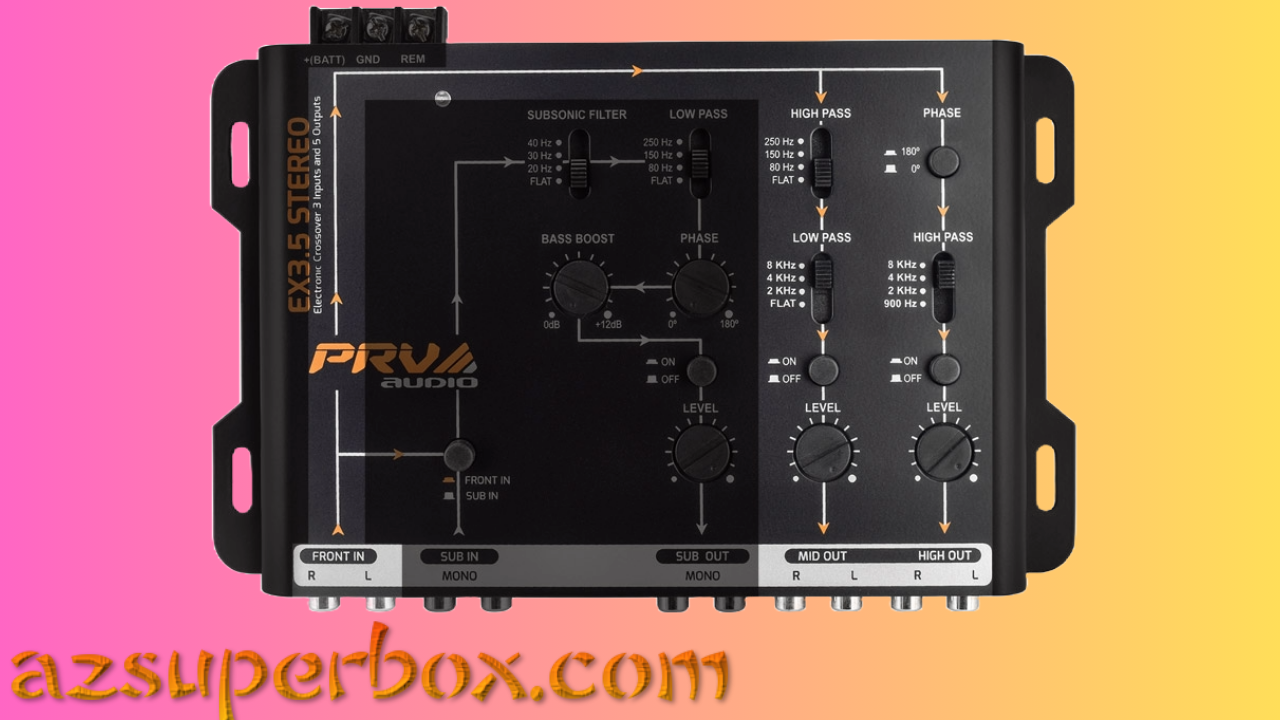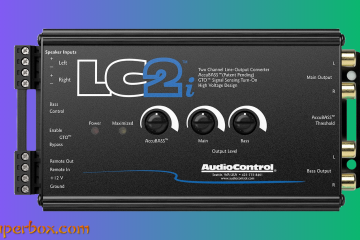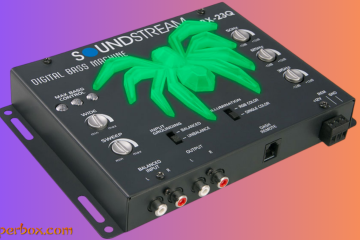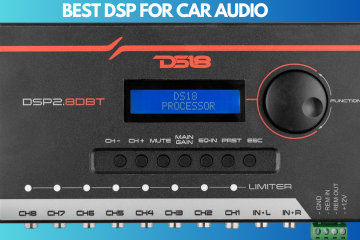This post contains affiliate links. AZSuperbox.com is a participant in the Amazon Services LLC Associates Program, an affiliate advertising program designed to provide a means for sites to earn advertising fees by advertising and linking to Amazon.com. As an Amazon Associate, I earn from qualifying purchases.
THE BEST CROSSOVER FOR CAR AUDIO
Choosing the right crossover for your car audio system is crucial for achieving optimal sound quality and managing the frequencies sent to different speakers. In this year, the market offers a variety of crossovers with different features and specifications. In this guide, we unveil the best crossovers for car audio that excel in precision, flexibility, and overall performance. Whether you’re building a high-fidelity audio setup or upgrading your factory system, these crossovers cover a range of needs and preferences. Join us as we explore the forefront of car audio technology and present the top choices that promise to enhance your in-car listening experience. Optimize your sound system with these outstanding crossovers that represent the perfect balance of performance and audio control.
Prv Audio Car Audio Crossover Ex4.6
PRV AUDIO Car Audio Crossover EX3.5
Clarion Mcd360 Car Audio Crossover
Taramps CRX4 Car Audio Crossover
Planet Audio EC20B Car Audio Crossover

The Planet Audio EC20B Car Audio Crossover is a versatile 3-way pre-amp electronic crossover designed to enhance your car audio system. With variable low pass and high pass filters, as well as subwoofer phase and bass boost control, it offers precise control over audio frequencies for optimal sound quality.
Key features of the EC20B include phase control, which ensures all audio signals are in sync, subwoofer level control for adjusting bass levels, and variable bass boost for fine-tuning low frequencies. Additionally, it features variable high pass and low pass filters to control the frequencies sent to full-range speakers and subwoofers.
Equipped with front, rear, and sub inputs and outputs, as well as a remote subwoofer control, the EC20B provides flexibility in connecting and controlling your car audio components. Whether you’re a casual listener or an audio enthusiast, this crossover offers the tools to customize your sound experience to your liking.

The Taramps CRX4 Car Audio Crossover is a compact and high-performance device designed for audio enthusiasts seeking competition-level sound. With a 12dB/8th 4-way electronic crossover, it delivers enhanced audio quality and allows for customizable sound adjustments.
Featuring a maximum input level of 8 volts and low harmonic distortion (THD) of less than 0.01%, the CRX4 ensures optimal audio output. It provides excellent channel separation (>80dB) and operates within a working voltage range of 10 to 15.5V DC. The electronic protection includes polarity reversal, ensuring the longevity of the device.
The CRX4’s compact design, with dimensions of 190mm x 145mm x 40mm, makes it versatile for various car audio setups. It offers different filter options for subwoofers, woofers, midrange, and super tweeters, allowing users to fine-tune their audio system according to their preferences.
For subwoofers, the LPF filter is adjustable from 40Hz to 275Hz with a 12dB/8th slope, and there’s a BassBoost feature adjustable from 20 to 65Hz, fixed at +6dB. The mid-low channel (woofers or midbass) has adjustable LPF and HPF filters ranging from 300 to 7,500Hz and 25 to 140Hz, respectively. The mid-high channel (drivers) offers LPF and HPF filters adjustable from 1,200 to 12,000Hz and 200 to 4,600Hz, respectively. Finally, the high channel (super tweeter) has an adjustable HPF filter ranging from 550 to 12,000Hz, all with a 12dB/8th slope.
In summary, the Taramps CRX4 Car Audio Crossover provides audiophiles with a powerful tool to optimize their car audio system. With precise controls and a compact form factor, it offers a customizable and high-fidelity sound experience for car enthusiasts.

The Clarion MCD360 Car Audio Crossover is a versatile 3-way electronic crossover designed to enhance your car audio system. It features inputs for two- or three-way system setups and offers rear fader control for added convenience. With 2/4/6 channel input options and 6-channel / 5-volt RCA outputs for front, rear, and subwoofer connections, the MCD360 provides flexibility for various audio configurations.
Equipped with front/rear/subwoofer level controls, subwoofer equalizer, and boost level controls, this crossover allows for fine-tuning of your audio settings to achieve the desired sound quality. The high-pass crossover frequency multiplier further enhances the audio performance by optimizing the frequency response.
Included with the MCD360 is a wired remote subwoofer level control, allowing you to adjust the subwoofer level from the convenience of your driver’s seat. The crossover also features gold-plated terminals for reliable and corrosion-resistant connections.
Measuring 6 inches in width, 3/4 inches in height, and 7 inches in depth, the compact design of the MCD360 makes it easy to integrate into your car audio setup. Whether you’re upgrading an existing system or building a new one, the Clarion MCD360 Car Audio Crossover offers the features and flexibility needed to optimize your car audio experience.

The PRV AUDIO EX3.5 Car Audio Crossover, part of the 12v Crossover / DSP & Audio Equalizer category, introduces innovation and technology to the automotive sound market. This electronic crossover allows users to customize their sound with adjustable HIGH PASS and LOW PASS filters, each with 3-way settings. It also features output level control on each channel and an adjustable BASS-BOOST option on the Sub Out channel, enhancing the overall audio system.
Key features of the EX3.5 STEREO include 2/4 RCA input signal options, a maximum output of 9 Volts RMS, and a Bass Boost ranging from 0 to 12dB set at 45Hz. The crossover slope rate is Butterworth 12 dB/Octave. The device offers quick On/Off buttons for each channel, facilitating easy control. The input and output functions include 2/4 RCA inputs for 2 Channels (1 Stereo and 1 Mono) and 6 RCA outputs for 3 Channels (2 Stereo and 1 Mono).
Crossover functions include a High Pass Filter for adjusting the beginning of the channel operating frequency, a Low Pass Filter for determining the end of the channel operating frequency, and a Bass Boost for providing gain attenuation at a center frequency of 45Hz. On/Off buttons allow quick control for each individual channel, and level knobs adjust the output signal on each channel.
The EX3.5 STEREO has specific highlights for the High Out, Mid Out, and Sub Out channels, each with selectable filter options and recommended applications for various speakers and components. The device’s general specifications include a maximum output voltage of 9V RMS, maximum input voltage of 4V RMS, signal-to-noise ratio greater than 90dB, input impedance of 10K Ohms, and harmonic distortion less than 0.02% THD. The crossover operates within a frequency response range of 20Hz-200KHz, with a supply voltage of 10V – 16V DC and current consumption of 200mA. The dimensions are 1.30″ x 9.25″ x 6.30″, and it weighs 1.45 lbs.
In summary, the PRV AUDIO EX3.5 Car Audio Crossover delivers a powerful and customizable audio experience for automotive sound enthusiasts, with precise control over frequency adjustments and versatile connectivity options.

The PRV Audio EX4.6 Car Audio Crossover, designated as the EX4.6 PRO, is an electronic crossover designed to bring innovation and technology to the automotive sound market. This crossover provides the capability to customize sound with a wide range of frequency adjustments, offering 4-way adjustable HIGH PASS and LOW PASS filters, as well as output level control on each channel. Additionally, it features a Bass Boost option on the Sub Out channel.
Key highlights of the PRV Audio EX4.6 PRO include 2/3/4 RCA input signal options, a maximum output of 9 Volts RMS, and a Bass Boost that can be adjusted from 0 to 12dB at a center frequency of 45Hz. It includes a quick On/Off button for each channel, and the crossover slope rate is Butterworth 12 dB/Octave. The unit supports 2/3/4 RCA inputs for 3 channels (1 Stereo and 2 Mono) and 6 RCA outputs for 4 channels (2 Stereo and 2 Mono).
The crossover functions include High Pass and Low Pass filters, each with adjustable settings to fine-tune the amplifier frequency response for different components. The EX4.6 PRO is designed for various applications, including tweeters, compression drivers, midrange speakers, woofers, and subwoofers.
Technical details of the PRV Audio EX4.6 PRO include specific frequency ranges for each channel, maximum output voltage, input and output functions, impedance output, dimensions, and weight. The crossover is built for versatility, allowing users to enhance and customize their car audio system for optimal sound quality.
Crossing Over to Clarity: A Guide to Car Audio Crossovers
In the world of car audio systems, achieving optimal sound quality involves careful consideration of various components, and crossovers play a crucial role in this pursuit. Car audio crossovers serve to direct specific frequency ranges to the appropriate speakers, ensuring a balanced and clear audio output. Whether you’re a car audio enthusiast or someone looking to upgrade their in-car sound experience, understanding crossovers is essential. In this guide, we’ll explore the key features, types, and considerations when incorporating crossovers into your car audio system.
A. Understanding Car Audio Crossovers
1. Purpose of Crossovers:
- Frequency Management: Crossovers divide the audio signal into different frequency ranges and send each range to the appropriate speakers (tweeters, midrange, and subwoofers).
- Avoiding Speaker Strain: By directing specific frequencies to the speakers best equipped to handle them, crossovers help prevent distortion and speaker damage.
2. Types of Crossovers:
- Active Crossovers: These crossovers are electronic circuits that split the audio signal before amplification, allowing for precise control over each frequency range. Often found in high-end systems, active crossovers require a power source.
- Passive Crossovers: Installed between the amplifier and the speakers, passive crossovers are composed of capacitors, inductors, and resistors. They are more common in factory-installed audio systems and aftermarket speaker component sets.
B. Key Features of Car Audio Crossovers
1. Crossover Points:
- Frequency Adjustment: Crossovers allow users to set specific frequency points for high-pass (tweeters and midrange) and low-pass (subwoofers) filters.
- Slope: The slope determines how quickly the frequencies outside the chosen range are attenuated. Common slopes are 12dB/octave, 18dB/octave, and 24dB/octave.
2. Adjustable Settings:
- Gain Control: Some crossovers include gain controls to adjust the output level of specific frequency ranges, allowing for fine-tuning of the system.
- Phase Control: Phase adjustments help align the timing of signals from different speakers, ensuring a cohesive soundstage.
3. Compatibility:
- Matching with Speakers: Ensure that the crossover points and slopes are compatible with the specifications of your speakers. This information is often provided by the speaker manufacturer.
C. Types of Car Audio Crossovers
1. Full-Range Crossovers:
- Built-In Systems: Many factory car audio systems include full-range crossovers, directing the entire audio spectrum to each speaker. While simple, they may lack the precision of aftermarket options.
2. Passive Component Crossovers:
- Component Sets: Aftermarket component speaker sets often include passive crossovers, dividing the audio signal between tweeters and midrange or mid-bass drivers.
3. Active Component Crossovers:
- Separate Amplification: Active crossovers are often used in conjunction with multiple amplifiers, allowing independent control over each frequency range. This setup offers maximum flexibility and customization.
4. Subwoofer Crossovers:
- Low-Pass Filters: Dedicated subwoofer crossovers are designed for directing low-frequency signals to subwoofers. They may include adjustable frequency points and slope controls.
D. Considerations When Choosing Car Audio Crossovers
1. Speaker System Configuration:
- Component vs. Coaxial: Determine whether your car audio system consists of component speakers (separate tweeters and midrange drivers) or coaxial speakers (combined components). Crossovers must align with the system configuration.
2. Power Handling:
- Compatibility: Ensure that the crossovers can handle the power output of your amplifier and speakers. Mismatched power handling can lead to damage.
3. Crossover Points:
- Tailored to Speakers: Choose crossover points that match the frequency response capabilities of your speakers. Refer to the specifications provided by the speaker manufacturer.
4. Slope Selection:
- Balancing Transition: Select the slope (dB/octave) based on the desired balance between smooth frequency transitions and attenuation of unwanted frequencies.
5. Installation Location:
- Space Availability: Consider the available space for installing crossovers. Some models are compact and suitable for tight spaces, while others may require more room.
E. Installation Process for Car Audio Crossovers
- Determine Placement:
- Choose a suitable location for mounting the crossovers. Common locations include inside the doors, under the seats, or in the trunk.
- Connect Wiring:
- Connect the audio input and output wiring to the appropriate terminals on the crossover. Follow the provided instructions and use high-quality wiring.
- Adjust Settings:
- Set the crossover points, slopes, and any other adjustable settings according to the specifications of your speakers and personal preferences.
- Securely Mount:
- Securely mount the crossovers in the chosen location using screws or other mounting hardware. Ensure that the crossovers are fixed in a stable position.
- Test and Tune:
- Test the audio system after installation to ensure that the crossovers are functioning correctly. Fine-tune the settings as needed to achieve the desired sound quality.
F. Conclusion
Car audio crossovers play a vital role in optimizing the performance of your car audio system, directing frequencies to the appropriate speakers and enhancing overall sound quality. Whether you opt for passive component crossovers in component speaker sets or active crossovers for a more customizable setup, understanding the features and considerations is key. Take the time to match crossovers with your speakers, consider power handling, and ensure proper installation for a seamless integration into your car audio system. With the right crossovers in place, you can elevate your in-car listening experience, enjoying clear and balanced audio across a range of frequencies.



